Siberian Stonechat Saxicola maurus
Rare vagrant. Eastern Caucasus, SE Turkey and W Iran, C Siberia, C Asia and the Himalayas to W/C China.
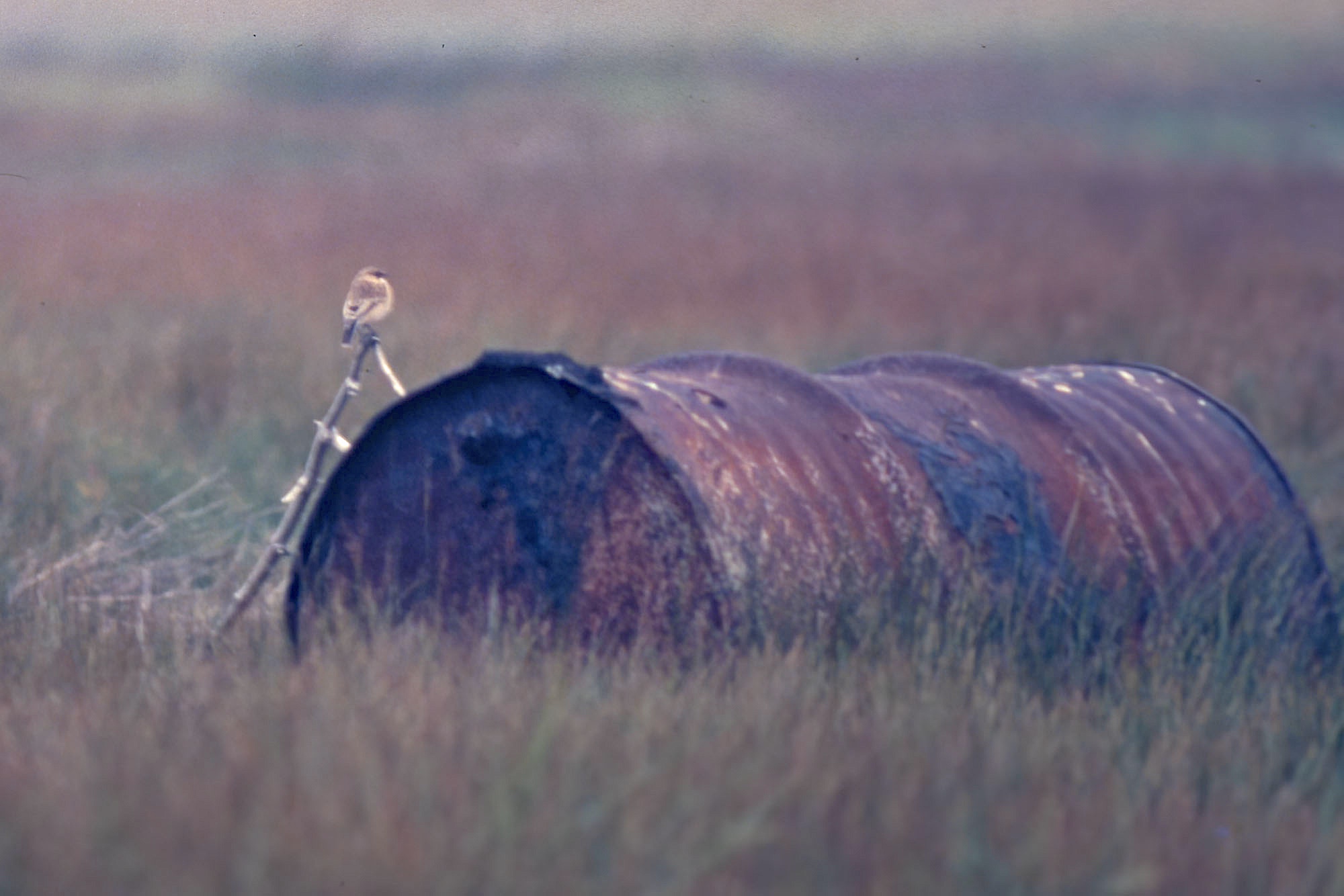
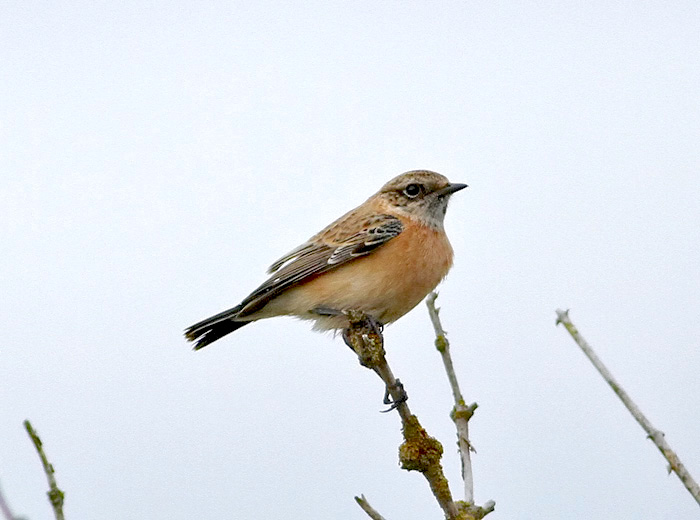
Siberian Stonechat: right, October 7th, 1978, Donna Nook (Graham Catley); right and below, October 5th 2013 Gibraltar Point (Russell Hayes).
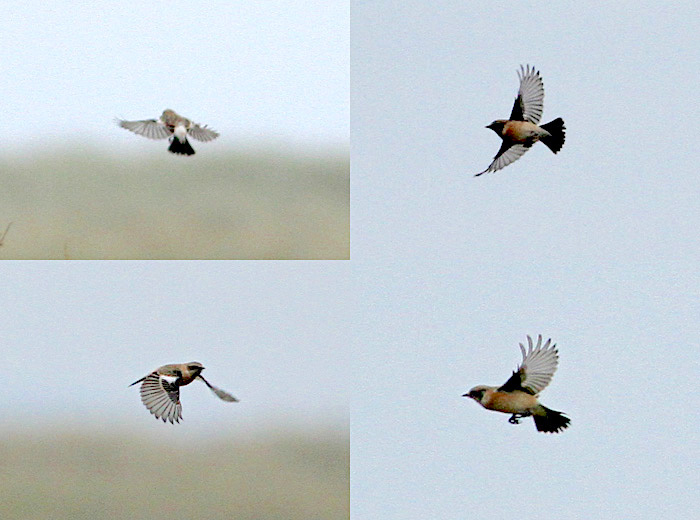
The taxonomy of the Stonechats, Saxicola sp., in Europe and Asia has been complex and studies on the group continue. Siberian Stonechat was split from what is now African Stonechat, S. torquatus, following work by Wittmann et al (1995). It is a complex polytypic species which continues to be intensively investigated using morphological and DNA data. IOC taxonomy (10.2) currently recognises five subspecies of which the nominate maurus is the one said to have predominantly occurred in Britain. One of these subspecies, stejnegeri, was split from Siberian Stonechat by IOC in 2009, becoming Stejneger’s Stonechat, S. stejnegeri, and was thus added to the British List following the adoption of IOC taxonomy by BOU and BBRC in 2018; field identification criteria have not yet been fully developed for this new species and BBRC requires confirmation by DNA analysis.
The first county record was an adult male at Donna Nook in May 1978 considered to be stejnegeri. Of the 10 records since, the two at Donna Nook in Oct 2016 were also considered to be stejnegeri, but no material for DNA analysis was obtained. On current knowledge, the other eight records remain as indeterminate maurus/stejnegeri. Apart from the adult male in 1978, those in 2013 and 2016 were also males, in their 1CY; the others were immature/ female types. A detailed analysis of the two birds in 2016 can be found in LBR 2016 (Catley and Lorand, undated). All records have been coastal, seven of them at Donna Nook which is clearly the site to watch for further records of this enigmatic group.
| Site | First date | Last date | Count | Notes |
| Donna Nook | 23/05/1978 | 1 | Adult male, some features of stejnegeri | |
| Donna Nook | 07/10/1978 | 08/10/1978 | 1 | 1CY male |
| Donna Nook | 09/11/1980 | 1 | 1CY/female | |
| Donna Nook | 02/10/1987 | 1 | 1CY/female | |
| Skegness | 21/10/1990 | 25/10/1990 | 1 | 1CY/female |
| Skegness | 23/10/1990 | 25/10/1990 | 1 | 1CY/female, a second bird |
| Donna Nook | 22/09/1994 | 1 | 1CY/female | |
| Saltfleet Haven | 01/10/2000 | 03/10/2000 | 1 | 1CY/female |
| Gibraltar Point NNR | 05/10/2013 | 1 | 1CY male | |
| Donna Nook | 06/10/2016 | 10/10/2016 | 1 | 1CY male; possible stejnegeri |
| Donna Nook | 14/10/2016 | 16/10/2016 | 1 | 1CY male, a second bird; possible stejnegeri |
| Donna Nook | 23/09/2024 | 28/09/2024 | 1 | 1CY female |
| Gibraltar Point NNR | 15/11/2024 | 18/11/2024 | 1 | 1CY male |
Descriptions of the two birds in 2016 are included in the article following the chart. Comments are invited on the features and identities of these two birds (they can be sent to recorder_north@lincsbirdclub.co.uk) as the observers felt that both were candidate stejnegeri.
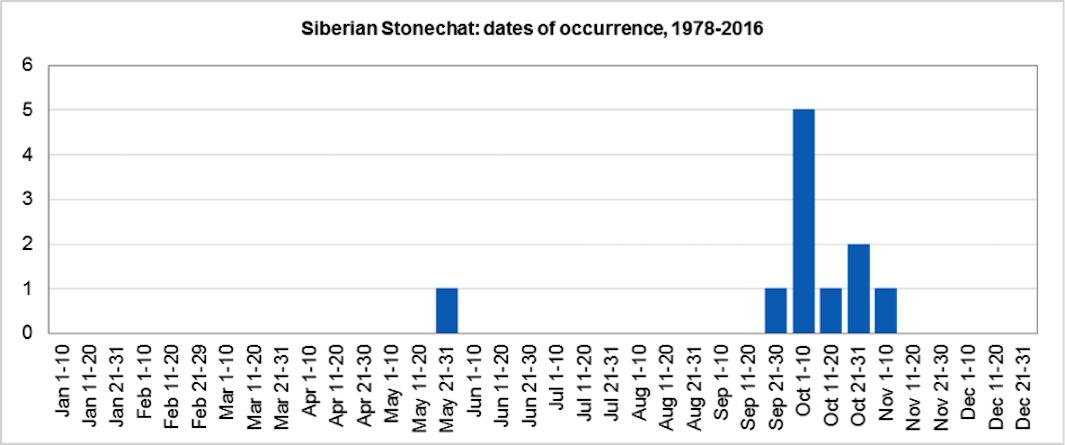
A discussion on the Siberian/Stejneger’s (Amur) Stonechats at Donna Nook, 6th-10th October and 14th-16th October 2016.
by Steve Lorand and Graham P. Catley(1) Putative Stejneger’s (Amur) Stonechat
Early October 2016 (writes SL) had seen a steady flow of thrushes, Yellow-browed Warblers and other eastern birds along the North Sea coasts and the fresh to strong easterly wind from the 4th onwards quickly gave rise to hopes of more to come. At the south end of Donna Nook, on the morning of the 6th, I had been searching without success for a Red-breasted Flycatcher which I had seen on the previous day, but was nonetheless pleased to be able to watch a few migrants including a couple of Yellow-browed Warblers and a Ring Ouzel in nearby bushes.
By 0950 I was walking along a stretch of dunes that borders a field, which has been growing lucerne for over forty years. A broad strip of set-aside runs along its full border and is separated, by a stock fence, from a grazing section of the dunes. As in most autumns, this rough overgrown strip and its fence are much favoured by European Stonechats and Whinchats, and this morning I scanned the area as usual. One bird flew onto the fence about 40 yards in front of me and as I raised my binoculars I was expecting it to be the Whinchat that had been around for several days. However, as soon as I saw the bird through binoculars, I realized that this was not the case, so I carefully edged closer to what I suspected might be a Siberian Stonechat. The bird was fairly wary and kept dropping to the ground out of sight amongst the dense vegetation, but I managed to take a few distant record photographs and became confident that the bird was at least a richly coloured Siberian Stonechat.
I put the news out onto BirdLine and also rang GPC who was about two and a half miles away at Pye’s Hall. I withdrew from the immediate area since the bird was so flighty and waited until Graham arrived about one hour later, accompanied by Chris Atkin, Neil Drinkall and Dave Hursthouse. Soon we were rewarded with some reasonable views, despite the bird’s regular incursions into the long vegetation, and Graham was able to obtain some better photographs. The wariness of the bird made it one of the least approachable Stonechats any of us had ever encountered. Often it would suddenly dart away, hover before landing, then disappear into the dense vegetation only to reappear at a considerable distance away some time later.
At distance, it resembled a female European Stonechat, but differing light intensities and viewing angles could cause some variation in impressions of the bird’s general colouration. It was overall darker and more richly coloured than any maurus birds seen by any of us, while the obvious sharply demarcated throat patch and the deep orange rump were particularly striking features. In very good sunlight, the dark mottled crown and ear-coverts contrasted with the pale cream supercilium that met just above the base of the bill. A broad dark line from the bill passed through the eye and widened to form a patch on the ear-coverts. The creamy throat patch was very conspicuous, particularly with the sharp demarcation from the warm peachy-buff of the breast and slightly paler belly. The undertail-coverts were whitish. The underwing was silvery-grey with black axillaries and underwing-coverts, thus determining the bird as a male. The upperparts were dark brown with orange-buff fringes on the mantle and scapulars. The greater coverts were tipped orange-buff. The primaries, secondaries and tertials were brown-black with cream fringes. The rump was a striking clean deep orange and the tail feathers were brown-black narrowly tipped with orange-white that extended along the outer webs of the outer feathers. One or two of Graham’s photographs show a creamy suffusion on the upper rump and also dark shaft streaks to two central uppertail coverts. The bill, legs and feet were blackish.
During its five-day stay, about 150 observers saw the bird. The difficulty of public access and the long walk necessary to reach this point obviously deterred some, while the fact that the bird often disappeared for long periods could make viewing frustrating. Several observers had to wait in excess of two hours before they achieved a sighting. I managed to see the bird on each day of its stay and on the second day when I accidentally flushed it at close range, it flew into some Sea Buckthorn and called a short, low, down-slurred whistle. At all times it remained in the same small area and became quite territorial, often driving away European Stonechats and Meadow Pipits, although it would tolerate other birds on some occasions. It was last seen on 10th October.
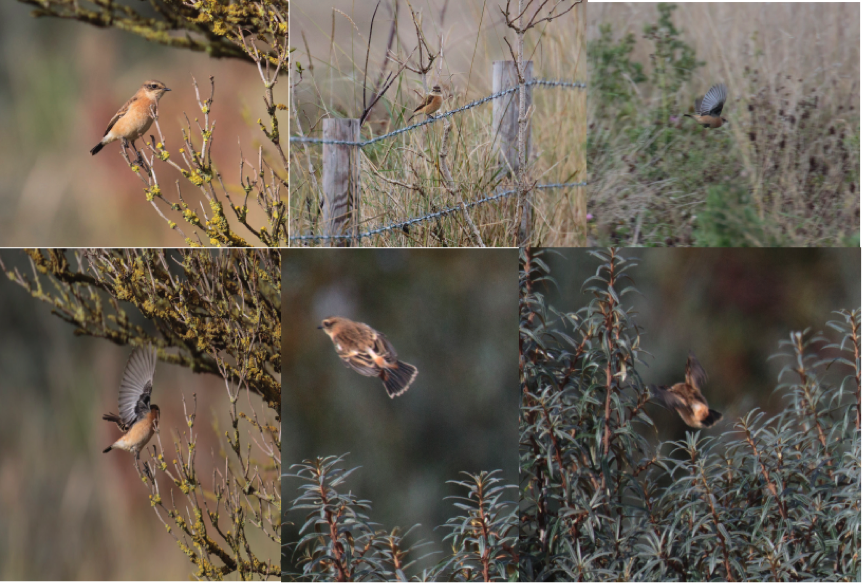
Photos of the first Siberian Stonechat at the south end of Donna Nook, 6th-10th October 2016. Photos courtesy of Graham Catley.
(2) Siberian of Stejneger's Stonechat ?
The easterly weather continued well into October and a few thundery showers on the 13th ensured that good numbers of migrants had been grounded by the following day. The list for the 14th was growing and as well as a complex array of commoner species, there were heartening totals of thrushes, chats, Goldcrests, Bramblings and Common Redpolls, plus 63 White-fronted Geese, four Bean Geese, a Cetti’s Warbler, a Yellow-browed Warbler, two Pallas’s Warblers and a Firecrest to add spice to the mix. A Red-flanked Bluetail was also still around for its fifth day and continued to draw admirers near the Stonebridge car park.
October 14th had been another of those days (continues GPC): after the euphoria of the previous days Paddyfield and Siberian Accentor duo Neil Drinkall (ND) and Graham Catley (GPC) had high hopes of finding something good on the Lincolnshire coast but after seven and a half hours of slog we had found four Tundra Bean Geese, 31 White-fronted Geese, a Firecrest and a Yellow-browed Warbler. We took time out to have more looks at the Red-flanked Bluetail then I suggested that we walk the outer dune ridge one more time for a late arriving wheatear. We walked out to the edge of the dunes at Stonebridge car park and started scanning the saltmarsh when a wheatear flew past and perched on a wooden fence post; needless to say it was a Northern but perched on the post next to it was a pale looking Stonechat; we both looked at it through bins and I said “Well, it has to be a Siberian” as it was clearly much paler and a different bird to the possible stejnegeri we had seen at the south end of Donna Nook a week previously.
We then looked at it through ND’s scope and I set out to get some images of the bird but it proved somewhat flighty at first and disappeared over the dunes. We rang Chris Atkin and Dave Wright who were in the car park, and SL, and all three joined us as we managed better views and tracked it down onto the fences near the car park.
Essentially as a European Stonechat in jizz and general structure but with distinctive plumage features:
- Bill, legs and feet: all black.
- Eye: black with narrow pale eye ring, most pronounced under the eye.
- Underparts: chin and throat to underside of ear coverts all off-white sharply demarcated from upper breast which was peachy orange with paler creamy feather tips forming a scaly pattern on the breast and belly with the vent and undertail coverts being white.
- Lores and ear coverts were pale dirty brown; hint of a paler supercilium, though this was less obvious than in the first individual. Crown, nape and mantle all a uniform, slightly grey-tinged fawn-brown background colour with darker blackish-brown streaking on the crown and narrow pointed blackish centres to the scapulars.
- Greater coverts were basally blackish with fairly broad white tips; alula black with a narrow white fringe; median wing coverts black-based with broad buff tips and fringes. Tertials blackish with a white tip and outer web the latter tinged buff towards feather bases. Secondaries blackish with narrow creamy buff outer webs forming pale panel on closed wing. Primaries blackish with narrow pale pointed tips. Tail feathers black with whitish tips. The rump was unmarked and deep orange becoming paler creamy towards the lower back. The uppertail coverts were the same deep, dark orange but with two blackish shaft streaks visible in photos. The underwing coverts were blackish and contrasted with pale undersides to the flight feathers, as for the first bird indicating that this was a male.
It fed in the manner of a European Stonechat making sallies after insects from perches but also spent quite a bit of time low down in the grass and marram, which was similar behaviour to the stejnegeri type seen the previous week.
We are assuming that this bird was a maurus but the depth of colour in the rump was unexpected and the dark centres to the uppertail coverts were much the same as the same area on the previous week’s Donna bird though that individual was darker on the underparts. The supercilia were also rather indistinct and there remains the possibility that this bird was a paler stejnegeri and not a maurus but without DNA evidence unfortunately on current criteria the true identity of these birds will for now remain indeterminate. There was no sign of the bird on 15th when it may have wandered to the marshes over the nearby sea-bank, but it was relocated and showing well in the original part of the area on 16th when it was seen and photographed by a number of observers.
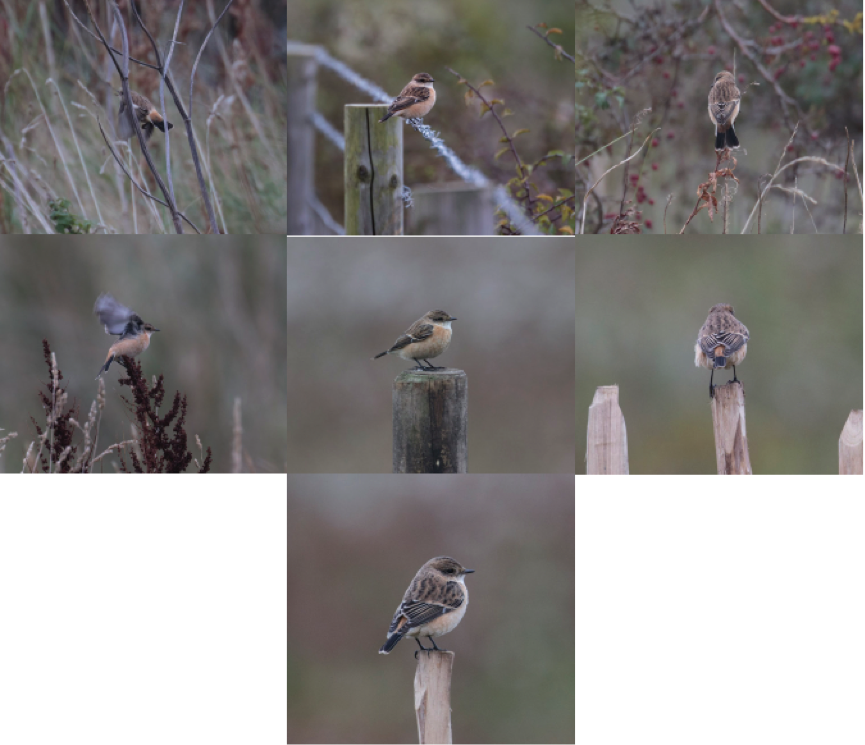
Photos of the second Siberian Stonechat at the south end of Donna Nook, October 14th-16th 2016.
Photos courtesy of Graham Catley.
Discussion
The Siberian Stonechat was classified as a race of Common Stonechat Saxicola torquatus until 2011, but is now recognized as a full species S. maurus. More recently, the East Asian race stejnegeri has been split as the distinct species Stejneger’s (Amur) Stonechat S. stejnegeri and accordingly maurus and stejnegeri will be treated as separate species by the BBRC for records from 2017 onwards (Holt et al. 2017).
2016 was an excellent year for Siberian Stonechats nationally, and 21 accepted records, including the two birds above, represented about double the average number of annual occurrences. The only two records definitely assigned to stejnegeri were each confirmed by samples of DNA. Phil Hyde, who also saw the earlier Donna Nook bird shortly afterwards saw one of these birds, at Landguard, Suffolk on 6th-7th October. He was struck by the close similarities in appearance and behaviour of the two birds and how they used similar habitat. However, without DNA samples, our present knowledge means that positively separating stejnegeri from maurus remains debatable and difficult. It seems that most records of suspected stejnegeri, including the first bird, will have to be assigned to Siberian/Stejneger’s (Amur) Stonechat for the time being.
Some photographs of the second bird revealed dark central shaft streaks on the deep orange uppertail coverts that, despite the bird’s overall paleness, offer some potential for consideration as a possible Stejneger’s (Amur). There is only limited published material discussing the determination of Stonechat taxa in the field, and the most useful recent material can be found in Garner (2014). The bird of 6th October closely corresponds with the information and photographs of stejnegeri in this work, while the second bird is a good match to maurus. As Garner stated, more research is required, and he stressed that there is little information from the range of overlap of stejnegeri and maurus.
References
Garner, M. (2014) Challenge Series: Autumn. Birding Frontiers, Sheffield.
Holt, C. and the Rarities Committee (2017) Report on rare birds in Great Britain in 2016. British Birds 110: 562-631.
Lorand, S. and Catley, G.P. (2018). Siberian/Stejneger’s Stonechats at Donna Nook, 6th-10th October and 14th-16th October 2016. Lincolnshire Bird Report 2016, 238-241.
(Account prepared December 2017; includes records to 2016)

